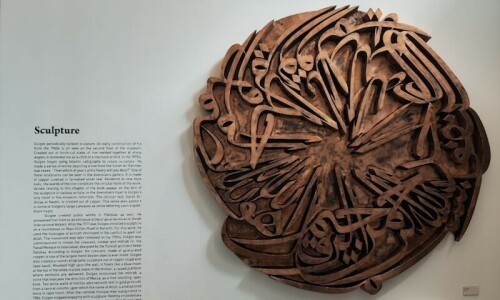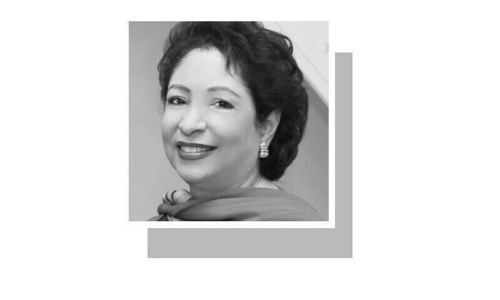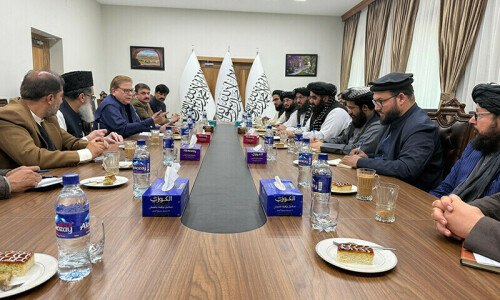A law to lament
THE punishment of stoning to death awarded to Zafaran Bibi has sent shivers down the spine of all humane people, at home and abroad. Behind the Zafaran tragedy is a law which continues to persecute vulnerable women in Pakistan. Stoning to death is a traumatic punishment, and demonstrations of outrage against it have saved some valuable lives. Still, there are hundreds of innocent women in jails of Pakistan on trumped-up charges of Zina.
Hadd punishments under the offence of Zina is stoning to death for adult married people and hundred stripes in public for others. In 1982, Allah Bux was sentenced to death by stoning, and Fehmida, a minor, was awarded 100 stripes in public. The two had eloped and the date of their Nikah was disputed. Women’s groups protested and finally, after a retrial, the couple was acquitted.
An unfortunate tale of Jehan Mina went unnoticed and the case was not promptly reported in the law digests. It was discovered in the files of the Federal Shariat Court, where 15-year-old Jehan Mina’s sentence was reduced.
Her uncle had filed a report with the police, alleging that his orphaned niece had been raped by his brother-in-law and nephew, while poor Jehan Mina was nursing her ill aunt. The trial court convicted Jehan Mina of Zina, as she was pregnant. She was awarded 100 stripes in public. The Federal Shariat Court acted in a more “charitable” fashion and reduced her sentence to three years of rigorous imprisonment and an infliction of 10 lashes in public.
At the same time the Federal Shariat Court held that “the failure to explain (pregnancy) is sometimes the most incriminating” evidence against an accused. Thus the onus is on a woman to prove the so-called bona fides of her pregnancy. Few know the fate of Jehan Mina, who gave birth to a still-born child, suffered the rigours of imprisonment and went mute with the shock of her experience.
In November 1987, a trial court in Karachi sentenced 25-year-old Shahida Parveen and her husband Muhammad Sarwar to death by stoning. Shahida was previously married to Khushi, who denied having divorced her. On the contrary, Shahida vehemently disputed it and claimed she married Sarwar after divorce was pronounced on her. Under the law, it is the duty of the husband to get the divorce registered. Ironically, if he fails to do so, it is the wife who takes the punishment for it under the Zina Ordinance.
In 1986, Gul Nisa was awarded death by stoning on a complaint filed by her estranged husband. He alleged that they were separated and, therefore, the pregnant Gul Nisa could not have conceived a child from him. Initially, Gul Nisa confessed under torture that she was having an affair but on appeal retracted her confession. A retrial was ordered and Gul Nisa was finally acquitted.
Forty-six to 48 per cent women in jails are accused of Zina. Their numbers run into hundreds. Every single day about a hundred women are arrested on the charge of Zina. The records of 1984 show that 1,843 cases of Zina against women were registered in that year alone.
Eminent but orthodox judges have justified the law on the grounds that in 85 per cent of the cases the accused women do eventually get acquitted. This alone should convince the lawmakers and the judiciary that the Zina Ordinance has a tremendous capacity for being abused. It is a sharp and cruel sword that hangs over the heads of women.
The morality of a society is not judged by the behaviour of an oppressed class but by the rules and laws made by the state, which either protect or exploit an already depressed section of society. To set a trap for a handful of promiscuous individuals, the Zina law has laid a minefield for women in difficult circumstances. There are several tales of injustice, where women may have escaped the Hadd punishment but were sentenced under Tazir or suffered imprisonment till finally acquitted. The incidents are numerous but some deserve mention, so that those who hold the Hadood ordinances as a sacred piece of legislation can be persuaded to disown them.
Safia Bibi, a blind girl, was convicted of Zina by a court in Sahiwal. Her confession was her unexplained pregnancy. The alleged rapists were given the benefit of the doubt and acquitted. An uproar convinced the rulers to influence the Federal Shariat Court to take notice of the case. She was acquitted but the underlying principle of convicting women on the basis of “unexplained” pregnancy was not reversed.
On the same basis, Tasleem Bibi was sentenced to five years’ rigorous imprisonment and awarded 30 lashes in public by the Federal Shariat Court in 1985. Rafaqat Bibi applied to the martial law authorities to instruct the police to file an FIR against influential people in her village who raped her. She was arrested by the police and in 1984 the court convicted her of Zina for being pregnant without proper “explanation”.
Courts in Pakistan have acted with less zeal on allegations of rape. They have made a fine distinction between “attempt” and “preparation” to rape. Attempt to rape received a heavy sentence of imprisonment, whereas “preparation” is punishable with a maximum sentence of two years. In the leading judgment which qualifies “preparation” the Federal Shariat Court seriously considered whether “the removal of (a garment) of the victim proceeded by a biting kiss on her cheeks would amount to preparation or attempt”.
In another case, bail was granted as the act according to the court fell under the definition of “preparation” and the honourable court lamented that the accused was caught saying: Aurnay na pai thay kay giriftar hum huay or Sar mundatay hi olay paray.
It is, therefore, quite understandable if women want a law victimizing them to be repealed. Pakistan’s society and institutions cannot be trusted to give women the dignity which they deserve in spite of its being guaranteed by the Constitution.
Brinkmanship at what cost?
DESPITE the presence of American military personnel on Pakistan’s soil, Indian Prime Minister Atal Behari Vajpayee’s threat of imposing a “decisive war” on Pakistan was just as surprising as his pronouncement a few hours later that “the sky is clear, but sometimes lightning can strike when the sky is clear”.
The basic question is, why should India, being a nuclear power, act in such an irresponsible manner and push the humanity to the brink of disaster? What have the Indians achieved? Have the war clouds disappeared?
While the Indian prime minister went into retreat after warning of “lightning,” New Delhi not only moved its ground forces much closer to the international borders and the LoC, it also deployed 525 aircraft, out of its total strength of 738 combat aircraft, at various forward bases of the western and south-western air command, covering Pakistan from Kashmir to the Arabian Sea. Some of these can deliver nuclear warheads.
This is in comparison to 353 of the PAF’s. A significant deployment in view of the fact that air power has a decisive role to play in any future wars.
According to credible information, the IAF has located 25 Mig-21 and Mig-29 at Srinagar; five Mig-27 at Awantipur; 50 aircraft including Mig-21, MIG-23 and Mig-29 at Patahankot; 40 aircraft (Mig-27, Jaguar and Mig-21) at Adampur; 25 at Halwara (Mig-29, Mig-21 and Mig-23); 15 Mig-21 and Jaguar at Chandigarh; 40 at Ambala (Jaguar and Mig-21); 15 at Bhatinda (Mig-21 and Mig-23), 15 Mig-21s at Sirsa; 30 aircraft at Suratgarh (Mig-21 and Mig- 29); 25 aircraft ( Mig-21, -23 and -27) at Bikaner; 10 (Mig-23 and Mig-29) at Jaisalmir; 50 at Jodhpur ( Mig-21, -23, -27 and Jaguar); 30 at Utarli (Mig-21, Mig-23, Mig-27); 30 Mig-21 and -27 at Naylya; 30 at Bhauj (Migs-21, -27 and -29), at Jamnagar 25 aircraft were deployed (Mig-27, -29, Jaguar and Mirage 2000) and 65 aircraft were deployed at Gawalyar including Mig-21, -23 and -27 and Mirage 2000.
Western intelligence reports suggest that the Indian Jaguar, Mirage 2000, Mig-27 and Mig-29 can deliver nuclear warheads. India is reportedly upgrading 150 Mig-21B fighters. The IAF has 88 Jaguars, 147 Mig-27s, and 53 Mig-23 BN/UMs configured in the strike/attack mode.
Its Mirage-2000Hs strike aircraft have significant nuclear strike capability. According to Western sources, it has 64 Mig- 29s. The Mig-27 and the Jaguar are strike/attack aircraft and, with little modification, could deliver nuclear warheads. Most of them are now deployed against Pakistan.
Moreover, Indians have pressed into service the short-range liquid-fuelled Prithvi missiles, mostly deployed in Punjab and Rajhastan. Prithvi SS-150 has a range of 150km, with a payload of 1,000kg; Prithvi SS-250’s range is 250km with a payload of 500-750kg; Prithvi SS-350 with a 350km range and a payload of 700-1,000kg. In addition, long-range Agni missiles have been developed to carry nuclear warheads.
In comparison, Pakistan’s F-16s and Mirages can deliver nuclear warheads. There are, reportedly, 32 F-16A/Bs and 56 Mirage-5s. It is also reported that several A-5s have been equipped for delivering atomic warheads.
Pakistan has recently acquired over 40 F-7 PGs ground attack aircraft to replace its F-6s. After the US went back on its commitment to deliver the remaining F-16s to Pakistan, thereby seriously undermining its strike capability, Pakistan focused on the various types of missile-based delivery system. It has since developed various types of short- and medium- range missiles using liquid and solid fuel. They include Ghauri, Shaheen and different versions of Hatf missiles.
The Hatf 1A has a range of 100km, and was tested on Feb 7, 2000. It is an improvement on the Hatf 1, which has a range of 80km, with a 500kg payload. Hatf 2 is a solid propellant missile with a range of 350km and a payload of 500kg; Hatf 3 has a range of 550km, although some sources put it at 600-800km.
In July 1997, Pakistan had reportedly tested the Hatf-3 when India had deployed Prithvi in Punjab.
Shaheen 1, believed to be a solid-propellant missile with a 750km range, has a 1,000kg payload; Shaheen II’s range is 2,500km and payload 1,000kg.
The Ghauri I (Hatf 5) is an medium-range missile, with a range of 1,300-1500km and a payload of 500-700kg. It can reach most cities in India. It had its first test flight on April 6, 1998, and flew 1,100km.
Since the role of air force is not only to defend air space, but also to provide support to the military and the navy, Pakistan’s counter-strategy consists in gearing up “all assets of air power,” be that of the army, the navy or the air force, besides the missile-based delivery system.
Indian deployment is perhaps aimed at denying Pakistan this capability, and the Indians seem to be eying on the infrastructure in a lightning strike to create a fait accompli.
For Pakistan, analysts believe, a first strike is the best course to protect its hardcore assets for launching a counter-attack. Perhaps, with this aspect in view, the Pakistan military experts have been advocating taking the war on the Indian soil.
Now the question is, why have the Indians built up war hysteria and what have they gained? First, it must be noted that the current stand-off has been whipped up as the American-led coalition entrenched itself in Afghanistan and there are reports, mostly from Western sources, that Al-Qaeda men have filtered into Pakistan and, perhaps, into Kashmir.
In view of the current Afghan situation the need for bases for the American-led coalition in Pakistan has lost significance, just as the development of SLBM (submarine-launched ballistic missile) had made U-2 flights from Pakistan useless and had encouraged the Kennedy administration to move closer to India.
Apparently the Indians have correctly understood the long-term strategic environment, whereas our men are concerned with short-term gains and do not bother about the inherent dangers of involving Pakistan in America’s so-called war against terrorism, without questioning their moral and legal status.
So, while the Indo-US strategic understanding has endured, we in Pakistan have been left in the lurch. The way the Western countries are pulling out from Pakistan is a dangerous sign for peace in the region.
By increasing the tension the Indians have perhaps also adopted a strategy of pushing up the cost of standoff and depriving Pakistan of any economic benefit. Perhaps the cost the standoff is now telling on Pakistan’s debt-ridden economy.
While the fatigue factor has become apparent owing to frequent increases in the cost of petroleum products and other utilities, what is most disappointing is that the Americans, whose war against terrorism Gen Musharraf has pledged to fight, have shown their bias and exerted pressure on him, using the same language which they did when Yasser Arafat was under Israeli siege. Even more surprising is the Indian statement that the presence of American troops in Pakistan would not deter it from embarking on its military objectives.
Now there are reports that the Americans are hinting at censuring Pakistan in the Security Council if it does not act to stop the so-called cross-border terrorism in occupied Kashmir. As nobody in the countries which believe in human dignity, fundamental rights and democracy is concerned about the killing of over 70,000 Kashmiris at the hands of the Indian security forces, and about hundreds of others killed by Hindu fanatics in Gujarat and elsewhere, the real peace will remain elusive.
Ali Imam — a legend
IN the death of Ali Imam, Pakistan has lost an advocate and interpreter of its cultural heritage.
Born in 1924 in Narsinghpur, the former CP and now Madhya Pradesh, Ali Imam’s schooling was in Hindi — and that explains the fact of his not being familiar with the Urdu script. Moreover, as he moved to higher classes, English became his medium of instruction.
Ali Imam’s hometown, Narsinghpur, was located at a short distance from Khajurahu. The landscape of the place is simply fantastic. The Vindhyachal region has a beauty of its own — perfumed air, red soil, a lot of game and a great deal of Kama Sutra done in reliefs and carvings on the exteriors of its temples. Almost an arcadia-like situation. Ali Imam felt the itch to imbibe some of the suggestions of the artistic atmosphere.
His elder brother Raza, now a well-known Indian artist living in Paris, was his immediate source of guidance. Ali Imam joined Nagpur School of Art and then went to J. J. School of Art, Bombay. He stayed there for two years. And then the partition came as a turning-point. He migrated to Pakistan. Later on, he settled in Rawalpindi and joined Gordon College. He did his BA in 1949. He often recalled his Gordon College days. His teacher Khwaja Masud played a key role in his development.
Ali Imam joined the Communist Party cell at the college and later on worked in the Potohar region. His first attachment was with the important trade unions of the region. He came into contact with Faiz Ahmed Faiz, Dada Mansur and Shakir Ali. The latter was a big influence on the artist in Ali Imam. He felt drawn toward the new forms — and the principle of movement and dynamism which they exuded.
Ali Imam went to England to acquire further training as an artist at St Martin’s School, London, and Hammersmith College of Art. On his return from England he felt that Pakistan was one such country where artist — particularly a good and real one — had no place. He couldn’t earn his living. After groping in the dark for some years he shifted to Karachi and served as principal of Central Institute of Arts & Crafts, Arts Council of Pakistan, for some time.
He created a wide circle of art lovers. Be it art, politics, religion and other cultural manifestations, to him art had to play the role of a redeeming agent.
Ali Imam was the only artist who faced the brunt of being a member of the Communist Party. Having remained the party’s contact man with Sajjad Zaheer, the secretary-general of the party, he knew what a hard life a worker of the Communist Party had to pass.
He also enjoyed the distinction of being a real-life character in Anwar Shemza’s novels. Few Urdu readers know that he was portrayed as a lively, fun-loving intellectual in Shemza’s novels.
A person who was known for his abrasive and pungent comments on fellow artists had to have a very small circle of friends. His house was frequented by all those who mattered in art, literature and politics. He was very fond of personalities like Faiz Ahmed Faiz and Mohammed Khalid Akhtar.
Many a painter was not able to have an exhibition of his paintings at Indus Gallery only because Ali Imam was not convinced they deserved a show at his gallery. He was a stickler for retaining his clients’ confidence in his gallery.
It was quite a surprise that Ali Imam returned to another spell of paintings towards the fag-end of his life and surprised us with his portraits of luminaries such as Amir Khusro, Ghalib, Sir Syed Ahmed Khan, Hali, Faiz and Sadequain.
He remained a progressive critic of art without forgoing his esteem and admiration for the best in the classical art. His return to portrait-painting showed his faith in discarding the cliches. What mattered to him was a manifestation of inner recesses of an artist’s mind.
His last visit to Islamabad and Lahore, in March 2002, — in what is known as having ‘Dialogue with Art’ — signified his love for the truth. His candid analysis exposed many reputed names. He would call most of them “a generation of imitators.”
No vultures circling over French defeat
So far, no Ali Bacher (and Majid Khan) have come forward to accuse France of ‘throwing’ the match against Senegal nor have other professional ‘accusers’ come out of their hibernation and claim with authoritative, inside-dope that the bookies had fixed the result.
No equivalent of Paul Condon has his snoops in the dressing-rooms of the teams, watching like hawks every move of the players. What was Yousuf Youhana whispering in the ears of his baby son? There will be no judicial inquiry and the bank balance of Zinedine Zidane will not be scrutinised.
This is an absurd way of starting a column on the 2002 World Cup. When Bangladesh beat Pakistan in the 1999 Cricket World Cup it was no less an upset than Senegal beating France. But no vultures were circling the skies. An upset is a part and parcel of sport. As my mentor on horse-racing Mile Coligno used to tell me; “If the favourite won every time, there would be no horse-racing.”
Football is a truly global sport and for the duration of the World Cup, our minds may be elsewhere but our hearts will be in South Korea and Japan. It doesn’t matter that there is no team from the subcontinent in the competition, we have all picked a team that we will root for.
In the past, for me it was Brazil. They played ‘Samba’ football in the way that the West Indies played ‘Calypso’ cricket. But this year I am pulling for any of the teams from Africa.
I loved the way Pape Bouba Diop took off his shirt after scoring a goal, place on the field and Senegal players danced around the shirt. This was pure joy, an unbounded innocence, what sport is all about. It really doesn’t matter whether Senegal makes any further progress in the tournament. They are already champions in their own country and there is poetic justice that Senegal was once a colony of France.
Pakistan Television is showing every match of the World Cup live and God bless them for it. A number of five-star hotels in conjunction with multinationals have put on large screens and are inviting people to watch the matches.
I have no quarrel with this but what I would recommend to the Pakistan government is that they place giant screens at parks and playing grounds so that people who cannot afford to go to five-star hotels can watch the matches. I can think of no better way of getting our people interested in football. It is a game that a country such as Pakistan should get passionate about.
I cannot see football replacing cricket as our first love but it is time that the subcontinent took to playing it at a serious competitive level. I think Pakistan needs to appoint a football supremo, the equivalent of a Nur Khan, if not Nur Khan himself.
Sports in its way is, perhaps, the only way of crashing through social barriers. It also generates a positive kind of nationalism and you get ‘feeling good about your country’ out of your system on a playing ground rather than a battle field.
I was shocked when I learnt of the death of Hansie Cronje in an air crash. Once over the shock I was deeply saddened. Here was a young man who had been dealt a good hand but he had played it badly. But he was trying to put his life together. He had accepted money from bookmakers to influence the course of matches and he was banned from cricket for life. What he had done was wrong, that’s about all it was.
It was not a heinous crime that had caused untold misery to thousands. There are those who are guilty of war crimes and statues are erected in their memory. Nelson Mandela was, as usual, charitable in the best sense of the word.
“Here was a young man courageously and with dignity rebuilding his life after the setback he had suffered a while ago. The manner in which he was doing that, rebuilding his life and public career, promised to make once more a role model of how one deals with adversity,” he said.
But Cronje’s death will not affect a criminal case against the former skipper in a match-fixing scandal, Indian police said. “Hansie is dead but the match-fixing case is alive,” said a top official from the Delhi police department.
So cussed is bureaucracy that it will pursue you beyond your death and if the Delhi police has its way, there will be no peace for Hansie Cronje even in the hereafter. What will they do? Slap a warrant of arrest on his grave?
I first met Hansie in East London in 1991 when I had gone to South Africa. Trevor Quirk, the South African commentator had introduced me to him and Allan Donald as we were spending a convivial evening.
Neither Hansie nor Allan had too much to say for themselves. They were, if anything, a bit shy and both were very likable persons. I add my condolences and sympathy to those of others who mourn his death.
I was also very sad to learn about the death of Subhash Gupte who surely was the world’s greatest leg-spinner ever until Shane Warne arrived on the scene. Subhash toured Pakistan with Vinoo Mankad’s team in 1955 and it was he who bat Maqsood Ahmed in the air and had him stumped by Tamhane for 99 at the Bagh-i-Jinnah in Lahore.
Less known is that when A.H. Kardar took a team to Mumbai a year previously to mark the Silver Jubilee of the Mumbai Cricket Association, Gupte had played against Kardar’s team and had taken all ten wickets in the first innings or it could have been the second innings.
Subhash was a combative cricketer on the field and off the field, apparently didn’t suffer fools gladly. He had some quarrel with an Indian cricket official, upped toots and settled in Trinidad in the West Indies. I liked him and he and I got along just fine.














































Dear visitor, the comments section is undergoing an overhaul and will return soon.